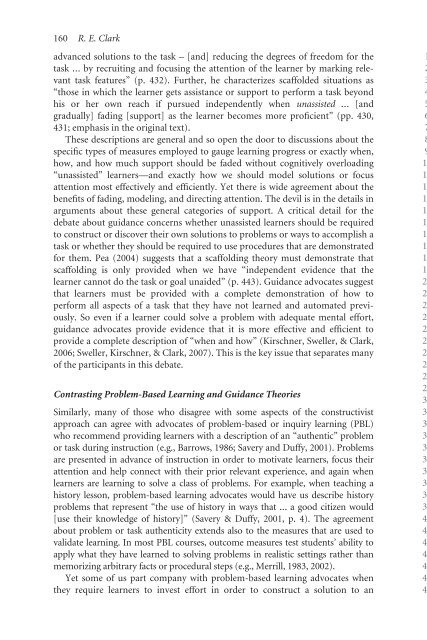9 How Much and What Type of Guidance is Optimal for Learning ...
9 How Much and What Type of Guidance is Optimal for Learning ...
9 How Much and What Type of Guidance is Optimal for Learning ...
Create successful ePaper yourself
Turn your PDF publications into a flip-book with our unique Google optimized e-Paper software.
160 R. E. Clarkadvanced solutions to the task – [<strong>and</strong>] reducing the degrees <strong>of</strong> freedom <strong>for</strong> thetask . . . by recruiting <strong>and</strong> focusing the attention <strong>of</strong> the learner by marking relevanttask features” (p. 432). Further, he characterizes scaffolded situations as“those in which the learner gets ass<strong>is</strong>tance or support to per<strong>for</strong>m a task beyondh<strong>is</strong> or her own reach if pursued independently when unass<strong>is</strong>ted . . . [<strong>and</strong>gradually] fading [support] as the learner becomes more pr<strong>of</strong>icient” (pp. 430,431; emphas<strong>is</strong> in the original text).These descriptions are general <strong>and</strong> so open the door to d<strong>is</strong>cussions about thespecific types <strong>of</strong> measures employed to gauge learning progress or exactly when,how, <strong>and</strong> how much support should be faded without cognitively overloading“unass<strong>is</strong>ted” learners—<strong>and</strong> exactly how we should model solutions or focusattention most effectively <strong>and</strong> efficiently. Yet there <strong>is</strong> wide agreement about thebenefits <strong>of</strong> fading, modeling, <strong>and</strong> directing attention. The devil <strong>is</strong> in the details inarguments about these general categories <strong>of</strong> support. A critical detail <strong>for</strong> thedebate about guidance concerns whether unass<strong>is</strong>ted learners should be requiredto construct or d<strong>is</strong>cover their own solutions to problems or ways to accompl<strong>is</strong>h atask or whether they should be required to use procedures that are demonstrated<strong>for</strong> them. Pea (2004) suggests that a scaffolding theory must demonstrate thatscaffolding <strong>is</strong> only provided when we have “independent evidence that thelearner cannot do the task or goal unaided” (p. 443). <strong>Guidance</strong> advocates suggestthat learners must be provided with a complete demonstration <strong>of</strong> how toper<strong>for</strong>m all aspects <strong>of</strong> a task that they have not learned <strong>and</strong> automated previously.So even if a learner could solve a problem with adequate mental ef<strong>for</strong>t,guidance advocates provide evidence that it <strong>is</strong> more effective <strong>and</strong> efficient toprovide a complete description <strong>of</strong> “when <strong>and</strong> how” (Kirschner, Sweller, & Clark,2006; Sweller, Kirschner, & Clark, 2007). Th<strong>is</strong> <strong>is</strong> the key <strong>is</strong>sue that separates many<strong>of</strong> the participants in th<strong>is</strong> debate.Contrasting Problem- Based <strong>Learning</strong> <strong>and</strong> <strong>Guidance</strong> TheoriesSimilarly, many <strong>of</strong> those who d<strong>is</strong>agree with some aspects <strong>of</strong> the constructiv<strong>is</strong>tapproach can agree with advocates <strong>of</strong> problem- based or inquiry learning (PBL)who recommend providing learners with a description <strong>of</strong> an “authentic” problemor task during instruction (e.g., Barrows, 1986; Savery <strong>and</strong> Duffy, 2001). Problemsare presented in advance <strong>of</strong> instruction in order to motivate learners, focus theirattention <strong>and</strong> help connect with their prior relevant experience, <strong>and</strong> again whenlearners are learning to solve a class <strong>of</strong> problems. For example, when teaching ah<strong>is</strong>tory lesson, problem- based learning advocates would have us describe h<strong>is</strong>toryproblems that represent “the use <strong>of</strong> h<strong>is</strong>tory in ways that . . . a good citizen would[use their knowledge <strong>of</strong> h<strong>is</strong>tory]” (Savery & Duffy, 2001, p. 4). The agreementabout problem or task authenticity extends also to the measures that are used tovalidate learning. In most PBL courses, outcome measures test students’ ability toapply what they have learned to solving problems in real<strong>is</strong>tic settings rather thanmemorizing arbitrary facts or procedural steps (e.g., Merrill, 1983, 2002).Yet some <strong>of</strong> us part company with problem- based learning advocates whenthey require learners to invest ef<strong>for</strong>t in order to construct a solution to an1234567891111111111222222222233333333334444444
















